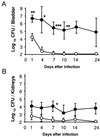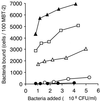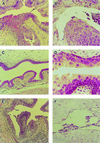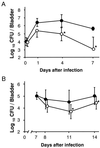Antimicrobial activity of intraurethrally administered probiotic Lactobacillus casei in a murine model of Escherichia coli urinary tract infection
- PMID: 11353622
- PMCID: PMC90542
- DOI: 10.1128/AAC.45.6.1751-1760.2001
Antimicrobial activity of intraurethrally administered probiotic Lactobacillus casei in a murine model of Escherichia coli urinary tract infection
Abstract
The antimicrobial activity of the intraurethrally administered probiotic Lactobacillus casei strain Shirota against Escherichia coli in a murine urinary tract infection (UTI) model was examined. UTI was induced by intraurethral administration of Escherichia coli strain HU-1 (a clinical isolate from a UTI patient, positive for type 1 and P fimbriae), at a dose of 1 x 10(6) to 2 x 10(6) CFU in 20 microl of saline, into a C3H/HeN mouse bladder which had been traumatized with 0.1 N HCl followed immediately by neutralization with 0.1 N NaOH 24 h before the challenge infection. Chronic infection with the pathogen at 10(6) CFU in the urinary tract (bladder and kidneys) was maintained for more than 3 weeks after the challenge, and the number of polymorphonuclear leukocytes and myeloperoxidase activity in the urine were markedly elevated during the infection period. A single administration of L. casei Shirota at a dose of 10(8) CFU 24 h before the challenge infection dramatically inhibited E. coli growth and inflammatory responses in the urinary tract. Multiple daily treatments with L. casei Shirota during the postinfection period also showed antimicrobial activity in this UTI model. A heat-killed preparation of L. casei Shirota exerted significant antimicrobial effects not only with a single pretreatment (100 microg/mouse) but also with multiple daily treatments during the postinfection period. The other Lactobacillus strains tested, i.e., L. fermentum ATCC 14931(T), L. jensenii ATCC 25258(T), L. plantarum ATCC 14917(T), and L. reuteri JCM 1112(T), had no significant antimicrobial activity. Taken together, these results suggest that the probiotic L. casei strain Shirota is a potent therapeutic agent for UTI.
Figures






Similar articles
-
Therapeutic effects of orally administration of viable and inactivated probiotic strains against murine urinary tract infection.J Food Drug Anal. 2023 Dec 15;31(4):583-598. doi: 10.38212/2224-6614.3474. J Food Drug Anal. 2023. PMID: 38526818 Free PMC article. Review.
-
Protective effect of Lactobacillus casei strain Shirota against lethal infection with multi-drug resistant Salmonella enterica serovar Typhimurium DT104 in mice.J Appl Microbiol. 2011 Jan;110(1):163-73. doi: 10.1111/j.1365-2672.2010.04884.x. Epub 2010 Nov 9. J Appl Microbiol. 2011. PMID: 21059159
-
Evaluation of profertility effect of probiotic Lactobacillus plantarum 2621 in a murine model.Indian J Med Res. 2015 Jul;142(1):79-84. doi: 10.4103/0971-5916.162127. Indian J Med Res. 2015. PMID: 26261170 Free PMC article.
-
Effect of orally-administered Lactobacillus plantarum LPLM-O1 strain in an immunosuppressed mouse model of urinary tract infection.Benef Microbes. 2012 Mar 1;3(1):51-9. doi: 10.3920/BM2011.0009. Benef Microbes. 2012. PMID: 22348909
-
Use of Lactobacillus spp. to prevent recurrent urinary tract infections in females.Med Hypotheses. 2018 May;114:49-54. doi: 10.1016/j.mehy.2018.03.001. Epub 2018 Mar 5. Med Hypotheses. 2018. PMID: 29602464 Review.
Cited by
-
Dietary factors affecting susceptibility to urinary tract infection.Pediatr Nephrol. 2004 Apr;19(4):378-83. doi: 10.1007/s00467-003-1410-z. Epub 2004 Feb 24. Pediatr Nephrol. 2004. PMID: 14986090 Review.
-
In vitro and in vivo inhibition of Helicobacter pylori by Lactobacillus casei strain Shirota.Appl Environ Microbiol. 2004 Jan;70(1):518-26. doi: 10.1128/AEM.70.1.518-526.2004. Appl Environ Microbiol. 2004. PMID: 14711683 Free PMC article.
-
Lactobacillus colonization status in infants with urinary tract infection.Pediatr Nephrol. 2009 Jan;24(1):135-9. doi: 10.1007/s00467-008-0974-z. Epub 2008 Sep 10. Pediatr Nephrol. 2009. PMID: 18781336
-
Shelf-life extension of refrigerated sea bass slices wrapped with fish protein isolate/fish skin gelatin-ZnO nanocomposite film incorporated with basil leaf essential oil.J Food Sci Technol. 2015 Oct;52(10):6182-93. doi: 10.1007/s13197-014-1706-y. Epub 2015 Jan 14. J Food Sci Technol. 2015. PMID: 26396365 Free PMC article.
-
The front line of enteric host defense against unwelcome intrusion of harmful microorganisms: mucins, antimicrobial peptides, and microbiota.Clin Microbiol Rev. 2006 Apr;19(2):315-37. doi: 10.1128/CMR.19.2.315-337.2006. Clin Microbiol Rev. 2006. PMID: 16614252 Free PMC article. Review.
References
-
- Andersson R E, Daeschel M A, Hassan H M. Antibacterial activity of plantaricin SIK-83, a bacteriocin produced by Lactobacillus plantarum. Biochimie. 1988;70:381–390. - PubMed
-
- Aso Y, Akaza H, Kotake T, Tsukamoto T, Imai K, Naito S The BLP Study Group. Preventive effect of a Lactobacillus casei preparation on the recurrence of superficial bladder cancer in a double-blind trial. Eur Urol. 1995;27:104–109. - PubMed
MeSH terms
LinkOut - more resources
Full Text Sources
Other Literature Sources
Medical
Research Materials

